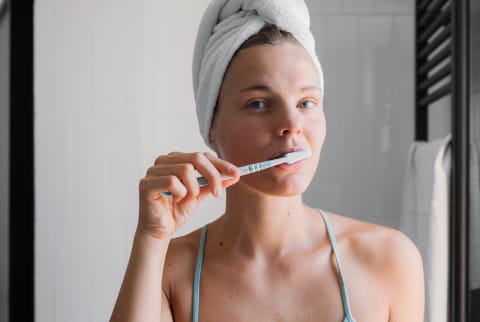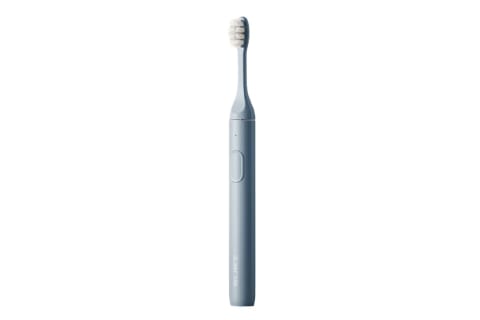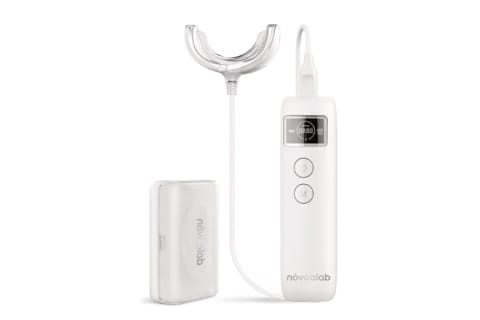Advertisement
The Oral Care Renaissance Is Here — But Are Dentists Backing The Trend?


The skin-ification of oral care is fully underway—let the dentists rejoice.
While it's somewhat cringey to admit it, having aesthetically pleasing toothbrushes and sleek, modern flossing devices may just impact the collective motivation to treat the teeth with as much care as we do our skin.
With all of the new cleansing gadgets and viral tooth serums popping up online, I had to know what dentists think about this oral care renaissance. To come, their response to the shift and a few take-home tips, so you don't get lost among the mushroom-flavored toothpastes (yes, really) and electric flossing wands.
The new direction of oral care
Now, the evidence for this shift is multipronged. On the social media front, more influencers are openly chatting about niche oral care topics, being met with plenty of engagement. For example, influencer and actress Claudia Suleweski took it upon herself to play big sister and share how she "saved her gums" and prevented recession—the video has gained 2.8 million views and counting.
Even Kim Kardashian has contributed to the buzz around viral products, like the distinct purple tooth serum from HiSmile, which some swear whitens their teeth in just one use.
Luckily, flossing is getting a rebrand as well, with devices like Flaus hitting the market—offering an electric, low-effort, and relatively sustainable alternative to traditional plastic flossing picks. (I've tried it, and it's pretty great!)
Red light has already become a norm in the skin care industry, but now these LED light therapy devices are tackling the mouth–more on the research behind those possible benefits in a bit.
And if you've never liked the lackluster mint and artificial bubblegum toothpaste options, now you can look forward to HiSmile's anticipated mushroom flavor toothpaste (though I'm personally unsure if that sounds any better…but to each their own).
Beyond products, special attention to the oral microbiome has also increased. Just like you can test various health metrics with an at-home kit, you can now do the same for your oral care with Peri—pretty cool, yeah?
The gist? At-home oral care is becoming many things: engaging, technologically advanced, and visually appealing. While many folks will stick with the basics, I'm sure Gen-Z (the generation who notoriously needs everything to have an aesthetic) will have fewer cavities and brighter smiles for it—if any of this actually works, that is.
Why dentists are here for it
It's safe to say that most dentists support more excitement and dedication to oral care habits—no matter where the inspiration comes from.
"It basically boils down to this: Products that you want to look at, touch, and smell are products you're more likely to use regularly. And as with other forms of self-care, including skin care, consistency is key in oral care," says dentist and co-founder of Cocofloss Chrystle Cu, DDS.
Encouraging patients to floss is a never-ending item on the to-do list of dentists everywhere, but these new products may just dial back the need for reminders.
"New routines are more easily established when they feel indulgent and delightful, so desirable products make habit-building more achievable," Cu says.
Celebrity cosmetic dentist Daniel Rubinshtein, DDS, agrees: "Creating visually appealing and fun-to-use dental products can increase their usage and adoption," he says. "By promoting dental care as part of 'self-care,' similar to skin care, it can change perceptions and encourage people to prioritize their oral hygiene, leading to better oral health."
In essence, this transition just might be something to celebrate.
The necessities vs. the extras
With all of the hype, it's easy to be convinced that you need every new, shiny product that surfaces. But just like dermatologists will tell you about skin care devices and gadgets—many of these advancements should be seen as extras. They're likely not necessary for the average person looking to maintain healthy teeth and gums.
Below, a brief breakdown of the basics, elevated basics, and extras from the pros to help you cut through the noise.
The basics
This probably won't come as a surprise, but here are your basic steps:
- Flossing: "Floss daily to remove plaque and food particles from between your teeth and along the gumline," Rubinshtein notes. Preferably, you'll do this at night.
- Brushing: "Brush your teeth twice daily along the gumline using a soft-bristled toothbrush," he suggests. The operative word here is soft. Too often basic toothbrushes come with harsh bristles that can irritate the gums and contribute to recession—so avoid that when you can. If you want a gorgeous color palette and sustainable design, consider the SURI Sustainable Electric Toothbrush—it's high-tech, travel-friendly, and makes brushing your teeth look cooler than ever.
- (Gentle) Mouthwash: Mouthwash is a touchy subject in the oral health community, but Rubinshtein does recommend it for most people—but not just any product. "Rinse with an antimicrobial, alcohol-free mouthwash," he instructs. This will help to reduce plaque and prevent gum infection. Alcohol-free is important, as highly antibacterial rinses can sweep away the good bacteria in your mouth as well as the bad, and you need a healthy bacterial balance for a thriving oral microbiome. That said, if you prefer to skip mouthwash, that's fine too.
- Visit your dentist regularly: Biannual checkups at the dentist are a must if you can swing it. Even with perfect at-home routines, cavities and gum inflammation can sneak their way in, and it's better to catch both sooner rather than later.
Elevated basics
Now, even oral care minimalists may crave an upgrade without the fancy gadgets. Below, a few easy ways to elevate your routine while still keeping it relatively low lift—take what interests you and leave the rest:
- Ditch irritating floss: Cleaning in between your teeth doesn't have to be painful. Cu's brand Cocofloss answers the call for a better string by utilizing vegan wax, cushioning coconut oil, and providing more fragrance options from orange to strawberry to coconut and more. From personal experience, this dental floss really does live up to the hype.
- Try oil pulling: Oil pulling is not "trendy" by any means (it's a practice that originated in Ayurvedic medicine), but like many other time-tested beauty practices (ahem, hair oiling), it has become increasingly popular among the TikTok crowd. There is some early evidence suggesting that oil pulling can help reduce bad bacteria in the mouth. However, it's not something the American Dental Association recommends, so approach this one with limited expectations. If you try oil pulling, it shouldn't replace your basic flossing and brushing routine—see it as an extra and check with your dentist before committing to this practice. However, if you do want to try it, it's easier than ever with the Keeko Morning Mint Oil Pulling Mouthwash Sachets, which combine several natural oils and extracts into user-friendly packages.
- Consider mouth tape: "Nasal breathing is paramount for both your oral and overall health," says Cu. "Chronic mouth breathing can contribute to oral microbial dysbiosis1, not to mention over-activity of the sympathetic nervous system2," which is why she recommends mouth tape for evenings (more on mouth taping here). Again, check with your dentist and general physician, as this may not be the best option for everyone.
- Grab a tongue scraper: While you can, of course, just use a toothbrush to brush the tongue, the unique shape of a tongue scraper helps it remove more bacteria per swipe3. I like the Boka Rasaga Tongue Scraper for the no-fuss design and affordable price point.
The extras
Some of you might already build in these steps above in your everyday routine. If that's the case, you may consider entering the fascinating world of high-tech oral care products. Here are just a few options (there are certainly more to explore!):
- Try a new flossing method: As mentioned earlier, Flaus is an electric flosser that really changes the game for those who can't be motivated by flavored floss alone. It's easy to use, the light vibration is irresistibly relaxing, and the design is sleek, so it looks great on the countertop. Slate is another great brand to consider—this one comes with gentle gum sweepers too.
- Give whitening kits a chance: If you want to whiten your teeth at home, consider picking up a whitening kit—these are often more effective (but also more expensive) than a whitening toothpaste. Here's a curated list of our favorite options on the market right now if you need a head start navigating the plentiful options.
- Explore blue & red light therapy: "Red and blue light therapy has potential benefits for oral health," Rubinshtein says. "Red light therapy stimulates healing, relieves pain, and improves circulation. Blue light therapy kills bacteria and aids in teeth whitening," he adds. Traditionally these LED treatments were administered by dental professionals but now come in at-home devices, like the Novalab Novoral Care Pro. Rubinshtein notes that individuals with oral wounds, pain, inflammation, periodontal disease, or tooth discoloration will benefit most.
Cu and Rubinshtein both recommend a quick consultation with your dentist before making any big purchases in the realm of oral care. Remember that you really only need the basic steps, but investing in products you're more likely to use is a step in the right direction for optimal oral care.
Shop products mentioned
The takeaway
Recent market and social media trends reveal a slow but steady "skin-ification" of oral care. Everything from floss to toothbrushes to oil pulling is becoming updated, visually appealing, and more user-friendly than ever before. The possible impact? More people feel excited to take care of their teeth and gums. While these extra products may seem frivolous to some, dentists agree that better oral hygiene is always a win, no matter where the inspiration comes from.



